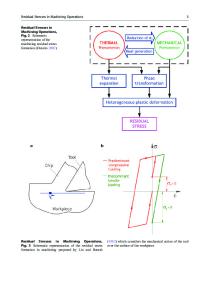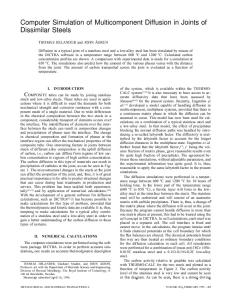Residual Stresses in Inertia-Friction-Welded Dissimilar High-Strength Steels
- PDF / 640,997 Bytes
- 11 Pages / 593.972 x 792 pts Page_size
- 81 Downloads / 338 Views
ERE is a constant drive within the aerospace industry to increase the efficiency of the engines being produced, for both economic and environmental reasons. One possibility for improving the efficiency is to reduce the weight and size of the engine components, which requires the tailoring of the materials’ properties across a component. In the present study, inertia friction welding (IFW) has been used to join Aermet 100, a very high-strength and high-toughness secondary-hardening steel, and S/CMV, a high-strength, heat-resistant, Cr-Mo pressure vessel steel. This design might enable the production of rotating gas turbine components that R.J. MOAT, N. IQBAL, and M. PREUSS are with the School of Materials, University of Manchester, Manchester, M1 7HS, United Kingdom. Contact e-mail: [email protected] D.J. HUGHES is with the Institute Laue-Langevin, 38042 Grenoble Cedex-9, France. A. STEUWER, formerly with the FaME38 at the Institut Laue-Langevin/European Synchrotron Radiation Facility (ILL/ESRF), is with the European Spallation Source (ESS) Scandinavia, University of Lund, 22350 Lund, Sweden. S.E. BRAY and M. RAWSON are with Rolls-Royce plc, Derby, DB24 8BJ, United Kingdom. Manuscript submitted September 25, 2008. Article published online July 24, 2009 2098—VOLUME 40A, SEPTEMBER 2009
can withstand very high torsional forces on the one end (Aermet 100) and exhibit sufficient properties at temperatures of several hundred degrees Celsius on the other end (S/CMV) of the component.[1,2] The fundamental principle of friction welding is to use the heat generated through motional friction to produce a clean joint, without the formation of a liquid phase.[3] The IFW involves using energy stored in a flywheel to rotate one-half of a component while the second half is forced into contact. This contact force first generates heat at the interface. Once the material has become sufficiently soft, the forging pressure applied against the two components forces the heated interface material into the flash, removing any surface contaminants and producing a clean joint.[3] Due to the rotational aspect of the process, IFW is particularly suited to welding cylindrical parts. The solid-state nature opens opportunities for joining materials previously considered to be unweldable and dissimilar materials. To date, only a small number of reports regarding dissimilar IFW are available in the public domain, with articles reporting the analysis of dissimilar Cr-Mo steels,[4] dissimilar stainless steels,[5] stainless steel and titanium,[6] dissimilar nickel superalloys,[7–9] and the steels welded in this study.[2,10,11] The joining METALLURGICAL AND MATERIALS TRANSACTIONS A
of dissimilar materials by fusion welding is often hampered by the formation of undesirable brittle phases during solidification and significant differences in the melting points between the two materials to be joined. In the case of IFW, the intermetallic phase formation when joining aluminum alloys to steel can still be a problem[12] but, due to the absence of a liquid phase
Data Loading...











